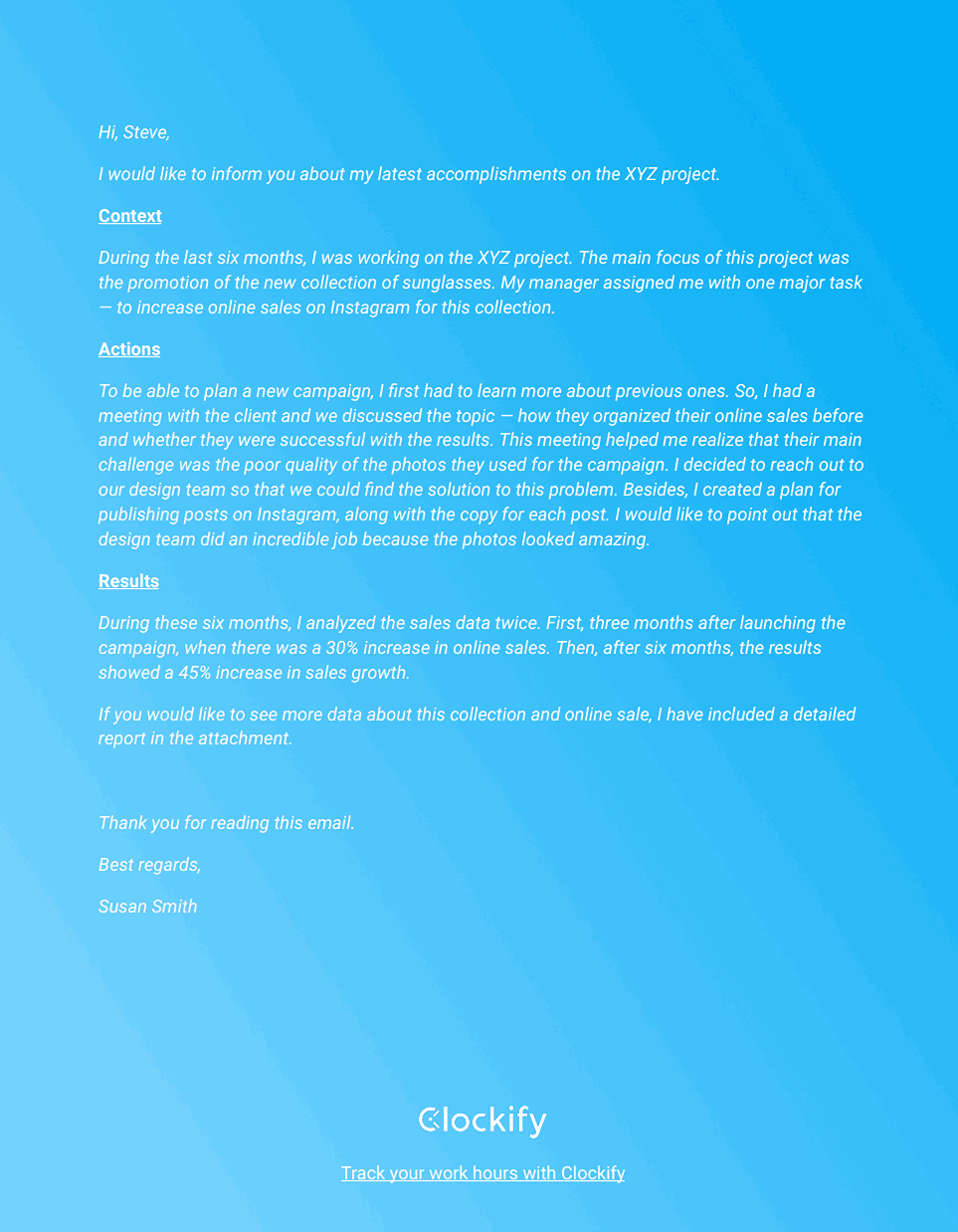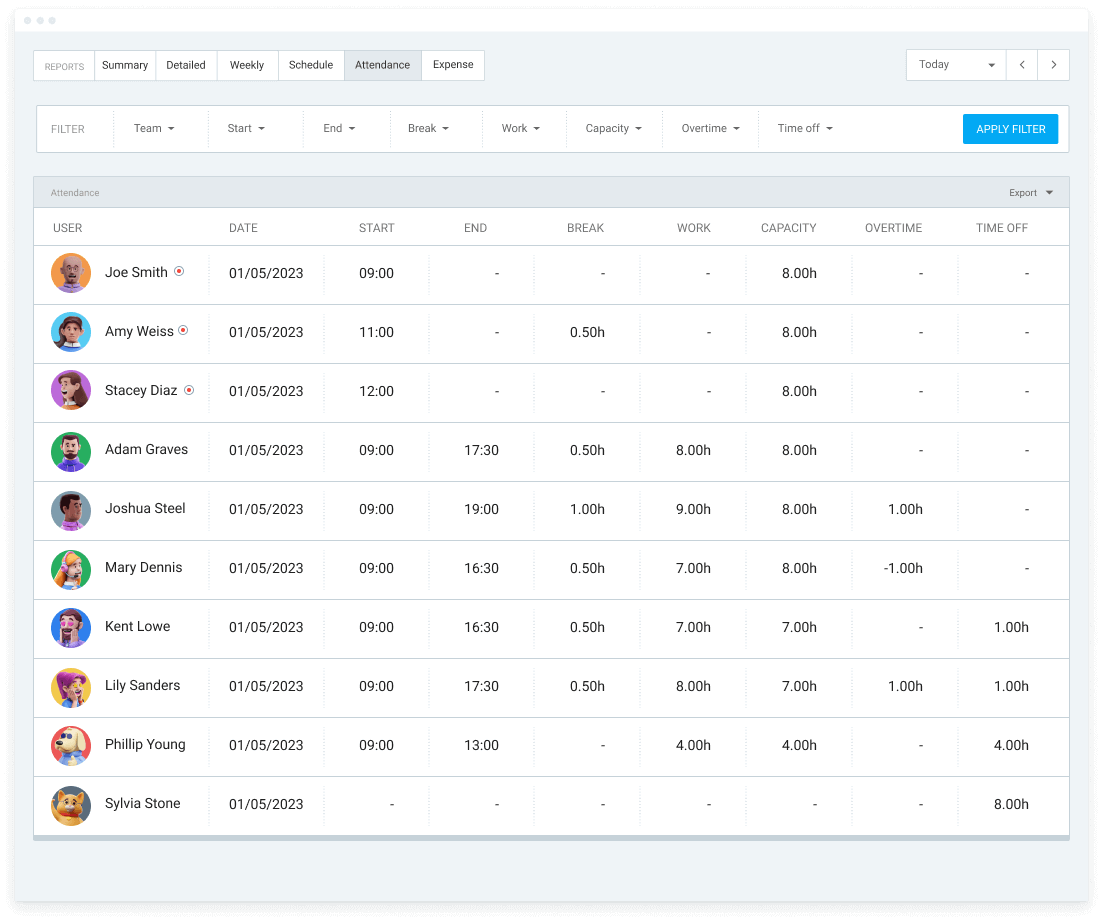How confident do you feel to talk to your boss about your accomplishments? If you’re like most people — not so much.
So, you’re probably thinking about how to provide your manager with the information about your work without sounding too boastful. For example, do you send an email to your boss, or do you address them in person?
This article brings you a solution for overcoming these problems. Plus, you’ll learn:
- How to present your achievements to your boss,
- How to make sure that you’re doing a good job, and
- How to show your value at work.
Let’s get into it.
- To present your achievements to your manager, opt for a team meeting, schedule a one-on-one session, or email your boss by using the CAR method.
- The best ways to improve your performance are to provide high-quality work consistently, learn as much as possible from others, be confident, and get social proof.
- Use a time tracking tool to log how much time you spend working on tasks.
How best to present your achievements to your boss?
If you’re unsure how to give your boss the information about your progress and accomplishments, we recommend the following methods.
Method #1: Post regular updates and schedule stand-up meetings
Rus Slater, author of The Management Coach, believes that employees should present their results during daily stand-up meetings and via regular written updates. In fact, a team chat channel in a dedicated business chat app can come in handy for both team meetings and written communication.
In his book, Rus Slater writes about 2 critical elements of regular updates:
“Each day each team member (including the manager) posts 2 bulleted lists:
- What they did yesterday, and
- What they are scheduled/planning to do on that day.”
Slater claims that this is a great way to:
- Highlight your achievements,
- Request timely support, and
- Foster team spirit.
Besides, this routine is convenient for managing remote teams, too.
💡 Clockify Pro Tip
Speaking of tasks, learn how to tackle them faster and better with our blog post:
Method #2: Schedule a one-on-one meeting
To discuss personal issues with your boss, schedule a one-on-one meeting with them.
Still, before you even address your boss formally to request a meeting, you need to list your recent achievements on a page or two.
Certified career coach Rita Friedman thinks that you should decide for which achievements you want to be remembered for:

“As you talk to your boss, be sure to focus mostly on the things you did well and really enjoyed doing. While you might also want to bring up 1 or 2 accomplishments that served the company well but you’re not madly passionate about, you don’t want to have a conversation about the things you don’t want to be known for.”
If you are wondering how to communicate these achievements, Friedman also states that this might depend on your company culture, your boss, and what you expect to get from that conversation.
To summarize, if you choose to talk to your manager face-to-face, here’s how to prepare for this occasion:
- Name all the tasks you enjoyed doing — the ones you want to be remembered for,
- Consider how you’ll present this information — this depends on the company culture and your boss’s character, and
- Revisit your intentions — whether you want to ask your manager for a raise or a promotion, or you want to talk about your future steps in the company.
In any case, schedule a one-on-one meeting with your boss whenever you feel you need eye contact with them to discuss urgent or sensitive matters.
Method #3: Send an email to your boss
Sometimes, you simply need to send an email stating your concerns or requesting work updates.
In that case, an effective email to your supervisor should contain the following elements:
- A subject line — write what the email is about, like Project concerns or Request for raise, or anything else that could pass as a descriptive subject line,
- A proper greeting — set the tone with a friendly yet professional salutation, either “Hi [First Name]” or “Dear Ms./Mr. [Last Name]” it depends on whether you have a more casual or professional relationship with your boss,
- A concise content — don’t waste your boss’s time by writing vague emails, instead, make it as concise as possible to enhance readability and just present your most successful work,
- A call-to-action (CTA) — make it clear to your boss what you want the next steps to look like, for example, “Please let me know when we can talk in-depth about my request” or “Please let me know whom I should contact regarding this concern,” and
- An adequate sign-off — leave a positive impression with a respectful goodbye note, as in “Yours faithfully”, “Thank you” or “Kind regards.”
Now that you know how to craft the content of your email and how to write an email from start to finish, let’s quickly touch on the CAR method. This is a tried-and-tested method for writing compelling emails in which you can talk about your accomplishments step by step.
Let’s explore it.
Method #4: How to show your value at work with the CAR method
To make your email to your supervisor persuasive, the CAR method focuses on 3 essential elements:
- C — context; for example, write a short yet on-point description of the project you’re working on,
- A — actions; for example, name all your experiences, challenges, and solutions while working on the project, and
- R — results; for example, show proof of how you came out as a winner.
Set goals and achieve more with Clockify
If you want to try the CAR technique, you’ll first need to explain the context in which your actions happened. Second, clarify what exactly these actions involve. Third, name the actual results that you achieved.
If you decide to use the CAR method, you can explain your achievements like a story. Here are some questions you can ask yourself when writing a sample email with the CAR method — in particular, for the results section:
- Have I solved an important problem?
- Have I come up with a new idea?
- Have I helped my coworkers reach a decision or make a meaningful change?
- Have I enhanced an overall turnover or sales figures?
- Have I helped my colleagues fulfill their goals?
- Have I received an award?
These questions are your reminder to add the crucial results to your email.
Let’s take a look at the example below. Susan is a social media manager at ABC, and here’s how she presented her latest results to her boss, Steve:

⏬ Download the CAR method email template
If you’re looking for a sample email on how to present your achievements to your manager, we hope you’ll find this template useful.
In any case, you’ve now learned how to address your boss via email and tip the scale in your favor!
—
Next, let’s look at 9 powerful tips to enhance your day-to-day work and career to leave a lasting impression on your boss.
How to make sure that you’re doing a good job at work?
Employees can choose to provide their bosses with the information about their progress for many reasons:
- They are overwhelmed with work and want to let their boss be aware of that,
- They want to plan their future in the company, or
- They want to ask for a promotion or a raise.
To get you closer to success, implement the following practical tips.
💡 Clockify Pro Tip
Find out more than 15 powerful ways to improve your work performance in our blog post:
Tip #1: Provide high-quality work
It’s so important to remind yourself that, if you want your manager to value your work, you must focus on providing high-quality output. You need to put your heart and soul into your work and your tasks. This means working hard and collaborating with colleagues.
Business owner and founder of AdmissionSight, Eric Eng, thinks that employees should take ownership of their projects to show they’re committed to their work:

“The key to impressing your boss with high-quality work is consistently providing good work and taking ownership of your projects. Actions speak louder than words. I even encourage my employees to take on challenging tasks and projects that showcase their abilities — this not only impresses me but also demonstrates their commitment.”
When you work relentlessly, you’ll show remarkable results. Thus, you’ll receive positive feedback from your team, manager, and clients.
Enhance performance with Clockify
Another clever move would be to keep all these appraisals in one place. Then, when you decide to talk to your boss, you can bring these documents with you as proof of your successful work.
In addition, you can include your team’s success as well. For example, create statistics or reports of your team’s results every 3 months or twice a year. This will show your commitment to the team.
💡 Clockify Pro Tip
Enhance your high-quality work further with these 15 productivity apps for Mac:
Tip #2: Show initiative
Whenever you can, volunteer to do the task that you’ve never done or go the extra mile on the current project. By showing proactivity, your superiors will see you’re worthy of your position in the company.
Human Resources Generalist at CAKE.com, Aleksandra Babić, explains what constitutes showing initiative at work:

“All behavior that surpasses the typical ‘work demands’ — but still contributes to higher quality work output — may be classified as showing initiative.”
To get ahead of everyone, Aleksandra Babić offers 3 pieces of advice on how to actually show initiative:

“For example, here are a few ways to show initiative:
- Take on more responsibilities,
- Get outside your comfort zone task-wise, and
- Offer to lend a hand to coworkers.”
Yet, these are only some of the behaviors that can show your boss how much you work.
CEO of Health Canal, a media company with 50+ employees, Erik Pham, thinks that leading initiatives showcases a proactive approach to work:

“Tackling complex projects when others may shy away showcases a proactive attitude and a commitment to personal and organizational growth. By offering to lead initiatives, individuals not only demonstrate confidence in their abilities but also inspire confidence in their colleagues.”
When you show initiative, you leave the impression of a person who wants increased responsibilities and professional development. As a result, your boss will likely view you as an indispensable asset.
💡 Clockify Pro Tip
You can only show initiative if you’re well-organized and hence have time for everything important. Read our guide to project management techniques and tools to enhance your organizational skills:
Tip #3: Be on time — always
You can work from an office or remotely. Either way, remember to be punctual, especially if your work hours are fixed. Besides, start performing your daily tasks on time.
Eric Eng stresses the importance of time management and scheduling tools to always be on the dot:

“Maintaining appointment punctuality fundamentally hinges on effective time management and respect for others’ time. Utilizing scheduling tools and planning for early arrival can facilitate this, reflecting one’s commitment and regard for time.”
Apart from that, many organizations require workers to log in their work hours. That’s one more reason to follow the company’s ground rules regarding business hours.
For the best results, use time and attendance software to get details on when employees:
- Start and end work hours,
- Take breaks, and
- Work overtime.

Since workers have to track their attendance, they tend to lower their number of absences. Also, when reviewing employee attendance records, employers are able to analyze the overall productivity of each worker.
💡 Clockify Pro Tip
If you want to learn more about measuring employee productivity, check out the blog post on this subject.
Tip #4: Learn as much as you can from others
Acquiring new skills and knowledge can only benefit you, even though it sometimes seems irrelevant. So, during brainstorming sessions or work meetings, listen carefully when your colleagues speak. The chances are that you’ll learn something new from your manager and your coworkers.
Aside from gaining new talents, remember to listen to your mentors. Since mentors have more experience than you, their advice and suggestions are extremely valuable.
Aleksandra Babić believes that everyone can benefit from engaging with their coworkers regularly and learning from those more experienced:

“The best way to learn from others is to see what they’re doing and how they perform their tasks. It’s critical to establish open and transparent communication, where you’ll be able to ask questions, listen to instructions, and remain open to feedback from more experienced colleagues.”
Next, Aleksandra Babić explains how you can make the most of this feedback by putting your ego aside:

“Throw your ego out the window and put aside any competitiveness in this learning process. Instead, try to be open to new challenges and opportunities to learn new stuff.”
To excel in your career, the most important thing you can do is to learn, try, and repeat.
💡 Clockify Pro Tip
One of the best ways to learn from others is through virtual meetings. Get 12 nuggets of wisdom for better managing virtual teams in the modern workplace:
Tip #5: Stand up for yourself
In the workplace, you must learn how to stick up for yourself — or do more self-advocacy at work. If you have a solid reason for doing a task the way you’re doing it, be ready to defend your ideas and beliefs if needed.
For example, when your boss is criticizing your ideas, don’t give up immediately. Be ready to support your opinions by giving clear explanations.
To stand up for yourself, NCHC co-founder Logan Nguyen says that employees should openly express their issues in a professional manner:

“The first step is to choose your battles wisely. It might seem like too much work, but believe me when I say that learning to pick your battles is crucial in building good work relationships and friendships. It’s also important not to be aggressive when communicating your needs. Use ‘I’ statements at all times to avoid sounding accusatory.”
Apart from that, Logan Nguyen believes that timing and compromise are critical:

“I would also advise getting your timing right. Avoid raising important matters during urgent meetings. Instead, schedule a private meeting with your boss to ensure the conversations are more productive. You must compromise when a need arises. You should be able to find a common ground where every party walks away satisfied.”
💡 Clockify Pro Tip
Another way to stand up for yourself is to say “no” when your deal with an impossible request. Learn how to handle this situation with our blog post:
Tip #6: Be confident
If you feel that you lack confidence in the workplace, here’s what you can do:
- Find out your strengths and try to incorporate them into your daily activities,
- Learn about your weaknesses and make a plan to minimize them,
- Don’t be afraid to ask for help from your colleagues, and
- Be open to challenges, even if you’re scared of stepping into unknown territories, such as a new project, go for it.
By following these tips, you’ll soon have higher self-esteem. Now, how to be confident when talking to your boss about your accomplishments?
Rita Friedman thinks being prepared is the best way to drum up some self-confidence in these situations:

“That time you spend considering what you do well and what you enjoy doing well — and building a list of achievements — should help remind you, too, that you do your job well. You might prefer to come up with a script or to just hash out some key talking points, but going into the discussion with examples of your value will help anchor the conversation.”
Friedman also points out that you need to think about what you want to get out of the discussion, whether you’re planning to request a raise, discuss a promotion, or new projects.
Then, simply request it, she says.

“Practice asking for it. Practice leaving space for silence. Practice talking about yourself to a friend or record yourself and watch it. And wear your power clothes, even if you’re Zooming it in.“
So, you see, confidence is a skill that you can work on. Then, once you’ve acquired this talent, you’ll be able to talk to your boss with ease.
Tip #7: Set clear goals and prioritize tasks
Research shows that employee performance can increase by more than 20% when employees align their work goals with their employer’s goals.
That’s why setting clear goals and prioritizing tasks can yield immense benefits if you want to advance your career or get a raise. Similarly, Eric Eng believes that a laser focus on your priorities helps you to course-correct along the way:

“Having a clear understanding of your goals and priorities helps you stay focused on the most critical aspects of your job. This also allows you to track your progress and make adjustments as needed.”
Along similar lines, you can opt to set SMART goals. In short, a SMART goal should be:
- Specific — clearly name and define your goal,
- Measurable — describe how you’ll measure progress on your goal,
- Attainable — learn if you have the skills and resources to achieve your goal,
- Relevant — get to the bottom of why the goal is important to you, and
- Time-bound — define when you’ll achieve the goal (the date and time).
To show your boss how valuable you are to the team, set clear goals and list tasks that will get you to achieve the goals.
💡 Clockify Pro Tip
If you want to learn about other types of goals and how to nail them, read our blog post:
Tip #8: Get social proof
The best thing someone can do to elevate your standing with your boss is to commend you and speak up on your behalf. Not many coworkers and clients are willing to do that, but this act of speaking kindly about your work achievements can completely change how your boss views you.
For example, a client or coworker may email your boss, expressing their gratitude for:
- Obstacles you helped them overcome,
- Services you offered them, and
- Results you achieved for them.
But clients and coworkers will rarely do it if you don’t openly ask for this social proof.
Logan Nguyen believes that you should approach your coworkers on this subject, but only when they aren’t busy or stressed:

“Before asking a coworker to speak up for you to your boss, you must ensure the timing is right, as you don’t want to approach them when they are busy or stressed. You also need to be clear and specific as to why you want them to advocate for you to make them feel comfortable.”
In other words, create a friendly and stress-free environment where your coworkers won’t feel forced to talk on your behalf.
💡 Clockify Pro Tip
Build an honest and trusting relationship with your coworkers by diving into our free guide:
Tip #9: Keep a work-life balance
Having a work-life balance is crucial for your physical and mental health. By managing your workday well, you’ll be able to be a great worker and still go home after your work hours.
To keep a consistent work-life balance, Aleksandra Babić thinks that it’s vital to set boundaries:

“Never cross your work boundaries — and find ways to rest and recharge during or after work hours. These can be things like taking regular breaks, getting physical exercise, and enjoying hobbies. A productive employee keeps their priorities close and focuses on concrete goals, without overburdening themselves.”
In other words — try not to stay late at work if you don’t have to and make sure to deliver what you’ve said you will.
Still, if you happen to stay late sometimes, be sure to log in these hours with an overtime tracker. An overtime tracker keeps tabs on how many hours you logged outside your typical work hours.
💡 Clockify Pro Tip
To make your work-life balance as consistent as possible, you need to learn to recognize signs of overworking. Find out the causes, effects, and steps for recovery in our in-depth guide:
Show your boss how much you work — with Clockify
Hard work should always be valued. But what if your boss doesn’t even know how successful your latest project was? Then, it’s up to you to inform them.
For the best results, you can show in-depth reports of where your time went during your work hours. With a time tracking tool like Clockify, you can supercharge the content of your email by attaching a time report for the past week or month. Here’s what it looks like in Clockify:

However and whenever you talk to your boss, it’s critical to act as soon as possible and not wait for your boss to recognize your achievements on their own. To make it easier for them to acknowledge your accomplishments, use the time tracking tool Clockify.



